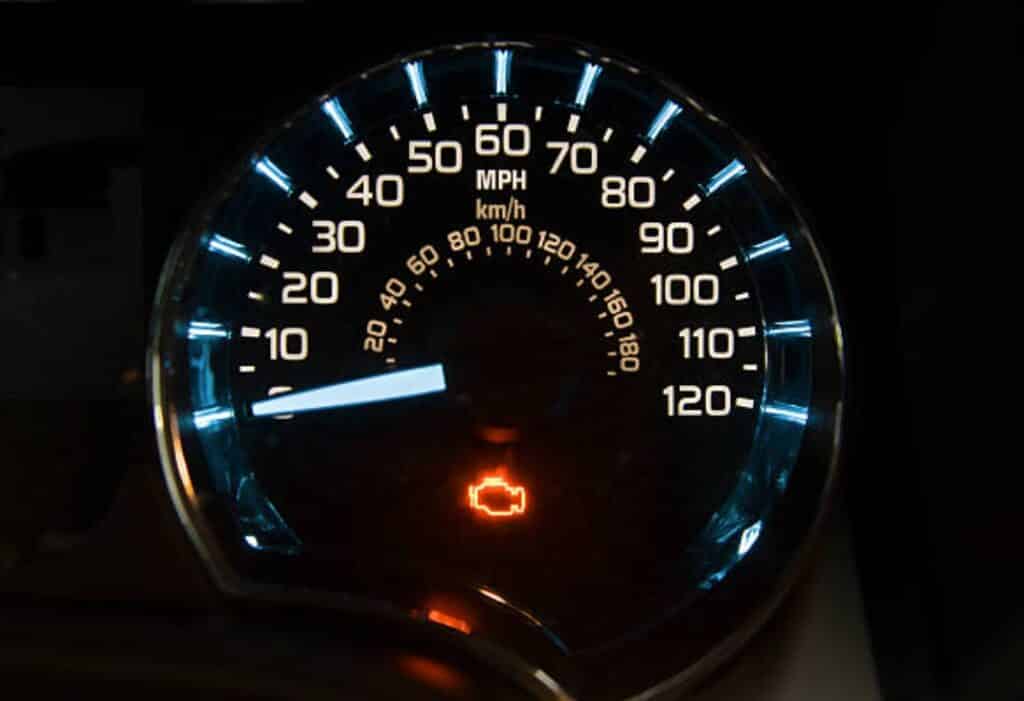The check engine light is a warning indicator on your car’s dashboard that tells you there is a problem with the engine. When it comes on, it’s important to check it with your OBD2 scanner, because in many cases it can be a sign of serious issues.
There are many causes of check engine light coming on, but here are the top 10:

1. Loose or damaged gas cap
The gas cap on a car is designed to create a seal that prevents fuel vapor from escaping into the atmosphere. If the gas cap is loose or damaged, this seal is broken and fuel vapor can escape. This can also cause the check engine light to come on in some cases.
While a check engine light can indicate a variety of different problems, a loose or damaged gas cap is one possible cause. As a result, it’s important to check the gas cap regularly and tighten or replace it if necessary. By keeping the gas cap in good condition, you can help prevent fuel vapor from escaping and keep your car running smoothly.
2. Faulty oxygen sensor (Lambda sensor)
Your car’s oxygen sensor (lambda sensor) is one of the most important components of the emission control system. The oxygen sensor is used to monitor the amount of oxygen in the exhaust gas. It is located in the exhaust pipe, before the catalytic converter.
If the oxygen sensor is not working properly, it can cause the engine to run too lean or too rich, which can lead to problems such as misfires, decreased fuel economy, and increased emissions. In some cases, a faulty oxygen sensor can also cause the check engine light to come on. While there are a number of reasons why an oxygen sensor can fail, some of the most common include physical damage, deposits on the sensor, and electrical issues.
3. Catalytic converter issue
A catalytic converter is a vital part of a car’s emissions control system, and it can fail for a variety of reasons. One common cause of catalytic converter failure is a build-up of debris on the catalyst itself. This can be caused by an engine misfire, which allows unburned fuel to enter the exhaust stream. Over time, this can lead to a reduction in the converter’s efficiency, and eventually, it will need to be replaced.
Another potential cause of failure is a blockage in the converter’s exhaust ports. This can be caused by a build-up of carbon deposits, or it may be the result of an obstruction in the exhaust pipe. If the check engine light comes on, it’s important to have the vehicle diagnosed with your OBD2 scanner as soon as possible to determine the cause of the problem. In many cases, a simple repair can fix the problem and prevent the need for a costly replacement.
4. Misfiring engine
One of the most common reasons why a car might have an engine misfire is because of a problem with the spark plugs. Over time, spark plugs can become fouled with oil, dirt, and other deposits, which can prevent them from firing properly. In some cases, the only way to fix the problem is to replace the spark plugs.
Another common cause of engine misfire is a problem with the ignition coils. Ignition coils are responsible for supplying the spark plugs with electricity, and if they fail, the spark plugs will not be able to fire. Once again, in many cases, the solution is to replace the ignition coils or spark plugs.
5. Mass air flow sensor issue
The air flow sensor is responsible for measuring the amount of airflow going into the engine. If there is an issue with the sensor, it may cause the check engine light to come on.
There are a few different reasons why your air flow sensor may have issues. It could be due to a build-up of dirt and debris, or it could be a sign that your sensor is going bad and needs to be replaced.
6. Evaporative emission control system leak
One possible reason why your car’s check engine light is on is because of an evaporative emission control system leak. The evaporative emission control system is responsible for collecting and storing fuel vapors from the fuel tank and keeping them from entering the atmosphere.
If there is a leak in the system, it can cause those vapors to escape, triggering the check engine light. In some cases, a leak in the evaporative emission control system can also cause the car to run rough or stall.
7. Exhaust gas recirculation valve issue
The EGR valve (exhaust gas recirculation) is responsible for recirculating a specific amount of the exhaust gases back into the engine cylinders. This process helps to reduce emissions and improve fuel economy. However, if the EGR valve becomes stuck open, it can cause an overheating problem.
Additionally, if the valve becomes clogged with carbon deposits, it can restrict the flow of exhaust gases, resulting in increased emissions. Therefore, it’s important to have the EGR valve inspected and serviced on a regular basis to prevent problems.
8. Intake air leak
A car can have an intake air leak for a number of reasons. One of the most common is a loose or damaged intake manifold gasket. These gaskets help to seal the connection between the engine and the air intake, and a leak can cause a loss of power and decreased fuel efficiency.
Moreover, another potential cause of an intake air leak is a crack in the intake manifold itself. This can happen as a result of age or wear and tear, and it can also be caused by an accident or impact. If you notice your check engine light coming on, it could be an indication of an intake air leak. In some cases, you may also hear a hissing sound coming from the engine compartment.
If you suspect that you have an intake air leak, it’s important to have it checked out by a qualified mechanic as soon as possible.
9. Throttle position sensor issue
The throttle position sensor is responsible for monitoring the position of the throttle. If it becomes damaged or dirty, it can cause the check engine light to come on.
The TPS is a sensor that tells the computer how far the throttle plate is open. When it’s not working correctly, it can cause all sorts of drivability issues, like poor fuel economy, loss of power, and stalling. In some cases, it can even prevent the engine from starting.
10. Vehicle speed sensor issue
The vehicle speed sensor monitors how fast your car is going and sends this information to the computer. If the check engine light is on, it means that the computer has detected an issue with the sensor or with the speedometer itself.
In most cases, this can be resolved by simply replacing the sensor. However, if the check engine light remains on after the sensor has been replaced, it may indicate a more serious problem with the speedometer or other parts of the car.
What Is The Most Common Reason For Check Engine Light?
The most common reason for the check engine light to come on is a loose or faulty gas cap. When the gas cap is not tightened properly or is damaged, it can cause a leak in the fuel system, which triggers the check engine light. This is a relatively minor issue that can be easily resolved by tightening or replacing the gas cap. However, other more serious issues can also cause the check engine light to come on, such as problems with the oxygen sensors, catalytic converter, or engine control module. It’s important to have the cause of the check engine light diagnosed and repaired by a qualified mechanic to prevent further damage to your vehicle.
What Causes Check Engine Light To Come On
The check engine light can come on due to a variety of reasons related to issues with the car’s engine or related systems. Some common causes of the check engine light coming on include:
Faulty oxygen sensor
Loose or damaged gas cap
Malfunctioning mass airflow sensor
Failing catalytic converter
Worn spark plugs or spark plug wires
Issues with the fuel system, such as a clogged fuel filter or failing fuel pump
Problems with the ignition system, such as a failing ignition coil
Vacuum leaks in the engine
Issues with the exhaust system, such as a leak or damaged muffler
Malfunctioning engine control module (ECM)
Other Reasons For Check Engine Light:
Here are some of the other causes for the check engine light coming on:
Loose gas cap – This is one of the most common reasons for the check engine light to come on. If the gas cap is not tightened properly, it can cause a leak in the fuel system, which triggers the check engine light.
Mass airflow sensor – The mass airflow sensor measures the amount of air entering the engine and helps the car’s computer adjust the fuel mixture. A faulty mass airflow sensor can cause the engine to run rich or lean, which triggers the check engine light.
Spark plug wires – The spark plug wires deliver the electrical current to the spark plugs, which ignite the fuel in the engine’s cylinders. If the spark plug wires are worn or damaged, they can cause misfires, which trigger the check engine light.
Exhaust system – The exhaust system is responsible for removing the carbon dioxide and other harmful gases from the car’s engine. A leak or blockage in the exhaust system can cause the check engine light to come on.
Fuel system – The fuel system includes the gas tank, fuel pump, and fuel injectors. Any issues with these components can cause the check engine light to come on.
Catalytic converter failure – The catalytic converter is responsible for converting harmful pollutants into less harmful emissions. A failed catalytic converter can cause the check engine light to come on and reduce the car’s gas mileage.
Oxygen sensors – The oxygen sensors monitor the amount of oxygen in the car’s exhaust system and help the car’s computer adjust the fuel mixture. A faulty oxygen sensor can cause the check engine light to come on and reduce the car’s gas mileage.
Faulty spark plug – If a spark plug is faulty, it can cause misfires in the engine, which triggers the check engine light.
If the check engine light comes on, it’s important to take your car to a repair shop as soon as possible. A mechanic can diagnose the issue and make the necessary repairs to prevent further damage to your car’s engine. Ignoring the check engine light can lead to more expensive repairs down the road.
In conclusion, the check engine light can be triggered by a variety of issues, including loose gas caps, faulty spark plugs, and catalytic converter failures. It’s important to have any issues diagnosed and repaired by a qualified mechanic to prevent further damage to your car’s engine and maintain good gas mileage.
How to know the causes of check engine light on your own
If you check engine light is in, it’s important to address the issue as soon as possible. This is because it could lead to more serious problems down the road.
With your own OBD2 scanner you can know what is going on in your car without having to rely on a mechanic. The Carly OBD2 scanner is a device that plugs into the car’s diagnostic port and reads the codes that are stored in the computer. These codes indicate what is causing the check engine light to come on.
If you have the Carly OBD2 scanner, you can use it to troubleshoot the problem yourself. This can save you time and money, and all you will need is the scanner, the Carly app, and your phone!


